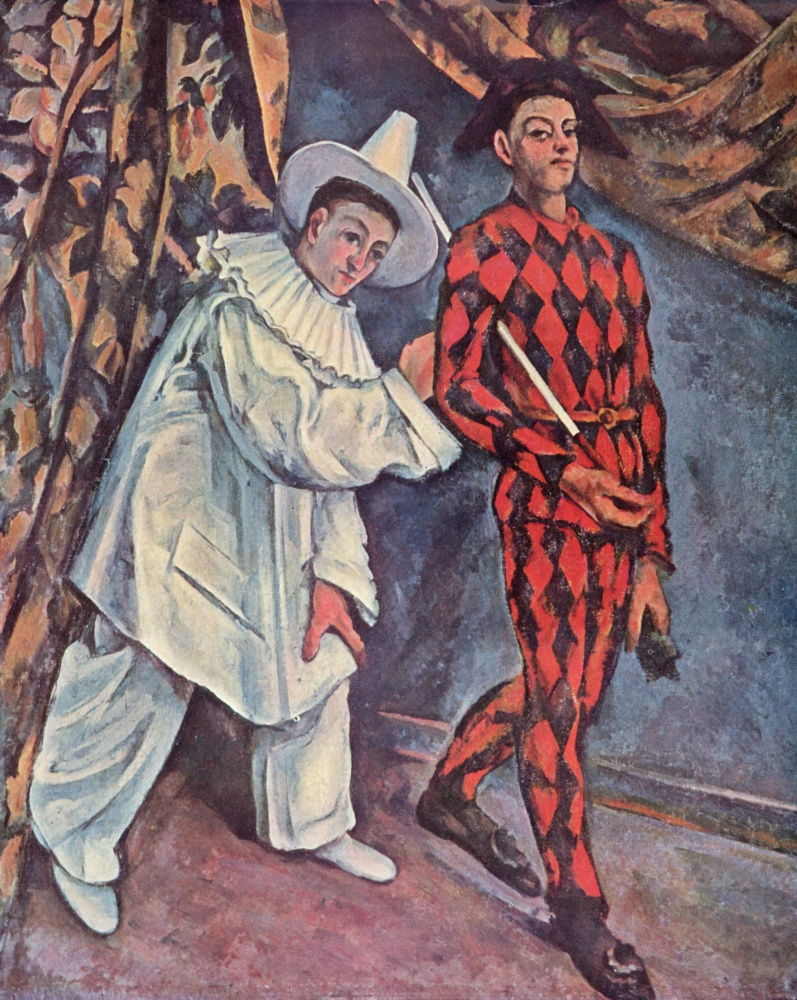log in
Enter site
Login to use Arthive functionality to the maximum
Pierrot and harlequin
Paul Cezanne • Pintura, 1890, 81×102.3 cm
Descripción del cuadro «Pierrot and harlequin»
In the second half of 80-ies of the XIX century, Paul Cezanne creates several works on theatrical subject. The model for it was the son who became interested in theater and participated in Amateur productions. One of these paintings — Paul cézanne "Pierrot and harlequin"(the second name — "Mardi Gras", in translation — "Carnival").
This canvas appeared due to the wish of one of his friends cézanne, Victor Shock, which unexpectedly became the owner of the inheritance. Buying yourself a small mansion, he wanted to decorate it with paintings and applied for ordering to Cezanne. He went to work, but pretty quickly lost interest: "Pierrot and harlequin" is the only painting by Paul cézanne, written-to-order Shock.
The canvas depicts the moment of going on stage the two popular characters of the Shrovetide carnival. The actors have already passed the open curtain, but it is not visible by the public and therefore not included finally in the role — that's why the painting of Paul cézanne Pierrot and harlequin is not like your characters. Cheerful harlequin looks haughty, his eyes sloping and expresses a mixture of contempt and superiority. It walks upright like a string and slightly pushing the case back, — perhaps because his back resting against a fist Piero. That, in turn, not like the sad romance: his posture suggests that, most likely, the actor has decided before the beginning of the pantomime "return" to advance the punches that he will receive during the presentation, because the plot of the harlequin laughs at the suffering of Piero, slamming his cane.
Harlequin and Pierrot were written by the artist with son and his friend; this painting by Paul cézanne executed in different techniques. To transfer sheen satin panels on tights jester, Cezanne added to the black paint a little blue. Masculatory of Pierrot's costume is accented by masterfully shaded folds, for which the artist used white, grey and greenish shades. To simulate makeup on the faces of the actors, Cezanne wrote their wet paint, achieving the most realistic colors. Each son Cezanne, posed in the form of Pierrot, went there once, tired of standing in a rather uncomfortable position.
Russian artist Serov, in 1904, published in the collection of Sergei Shchukin painting of Paul Cezanne's "Pierrot and harlequin", was impressed. His first reaction was quite unexpected: he called drawn characters, wooden dummies, however, according to the testimony of his friends, this did not prevent him at every visit Shchukin often to stay in front of the canvas and for a long time looking at it. As recognized by Serov himself, this picture does not come out from his head like Manila to itself its mysteries.
Today this work is a Cezanne exhibit at the State Museum of fine arts. Pushkin (Moscow).
This canvas appeared due to the wish of one of his friends cézanne, Victor Shock, which unexpectedly became the owner of the inheritance. Buying yourself a small mansion, he wanted to decorate it with paintings and applied for ordering to Cezanne. He went to work, but pretty quickly lost interest: "Pierrot and harlequin" is the only painting by Paul cézanne, written-to-order Shock.
The canvas depicts the moment of going on stage the two popular characters of the Shrovetide carnival. The actors have already passed the open curtain, but it is not visible by the public and therefore not included finally in the role — that's why the painting of Paul cézanne Pierrot and harlequin is not like your characters. Cheerful harlequin looks haughty, his eyes sloping and expresses a mixture of contempt and superiority. It walks upright like a string and slightly pushing the case back, — perhaps because his back resting against a fist Piero. That, in turn, not like the sad romance: his posture suggests that, most likely, the actor has decided before the beginning of the pantomime "return" to advance the punches that he will receive during the presentation, because the plot of the harlequin laughs at the suffering of Piero, slamming his cane.
Harlequin and Pierrot were written by the artist with son and his friend; this painting by Paul cézanne executed in different techniques. To transfer sheen satin panels on tights jester, Cezanne added to the black paint a little blue. Masculatory of Pierrot's costume is accented by masterfully shaded folds, for which the artist used white, grey and greenish shades. To simulate makeup on the faces of the actors, Cezanne wrote their wet paint, achieving the most realistic colors. Each son Cezanne, posed in the form of Pierrot, went there once, tired of standing in a rather uncomfortable position.
Russian artist Serov, in 1904, published in the collection of Sergei Shchukin painting of Paul Cezanne's "Pierrot and harlequin", was impressed. His first reaction was quite unexpected: he called drawn characters, wooden dummies, however, according to the testimony of his friends, this did not prevent him at every visit Shchukin often to stay in front of the canvas and for a long time looking at it. As recognized by Serov himself, this picture does not come out from his head like Manila to itself its mysteries.
Today this work is a Cezanne exhibit at the State Museum of fine arts. Pushkin (Moscow).


